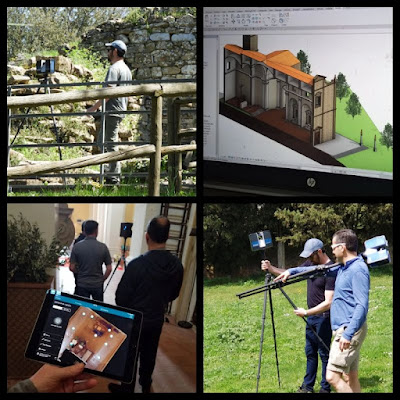Memories of six years ago. I
honestly thought I would be back in Volterra with this group of friends but
stuff happens. First it was covid, then my cancer diagnosis and now the
business of setting up my "exit strategy" for when the time comes to
leave Dubai.
I hate the term "reality capture". It sounds
like we are putting life itself in prison. But that fortnight in 2018 absorbing
the sights and sounds of a Tuscan hill town that has been continuously occupied
for 3000 years, that was truly magical.
Thank you to Mark Dietrick, Assoc. AIA,
LEED AP and Paul
Aubin for
enticing me into that experience. Bottom left is inside San Giusto using the
Matterport to capture the interior. Top right is my Revit model of that
"rustic baroque" church which has been developed further since.
Churches and temples offer such a fascinating topic for comparative history.
Kudos to David Dreffs, Tristan Randall, LEED AP
BD-C Young guys
(to me) so comfortable with the hardware and software, able to liberate rather
than capture. "keeping it real"... language is so slippery, a complex
web of neural connections. Real time render. Is there a false time render?
Virtual falsity?
Volterra 2018. Special time.
Deja Vu all over again. A historic
spire shrouded in scaffolding goes up in flames. Renovation project turns to
tragedy.
I visited Copenhagen in 2017 on my way to a conference.
Took several photos of the 17th century bourse, or stock exchange, a long low
red-brick building with elaborate gables and a very unusual spire. Dragons with
their entwined tails pointed to the sky.
There is a statue of Neptune at the entrance. Symbol I
suppose of Denmark's wealth from shipping, (herring fishing, rivalry with the hanseatic
league, union with Sweden.)
It's a wonderful city. I have done a BIM-pencil study of the Klint churches and learned a lot. Would love to go again but there are dozens of cities I would like to visit and to be honest my ability to travel is beginning to push against limits.
Let's hope the restoration project generates as many fascinating images as Notre Dame de Paris. It's truly fascinating to see traditional craftsmanship proceeding trade by trade. Copenhagen will rise to the challenge. A sad moment but also an opportunity to show strength and resilience.
My response to the Volterra
experience. I used Revit and digital painting in equal measure to process my
ideas and emotions, to understand the structure of the town better, to probe
the technical details that caught my attention.
This process is reflected in several posts on my blog
for those who want to hunt it down. For me I just enjoy looking back at that
burst of energy and the special memories it invokes.
I thought nothing of extracting contours from a jumble
of GIS files, stitching them together, simplifying, and generating a
toposurface for the entire locality. For no other reason than my own curiosity.
Accuracy be damned, I needed to produce something that would allow my brain to
sift through all the diverse information and sensory overload to move forward,
express my own ideas and ask penetrating questions.
This is the kind activity I live for, BIM dynosaur that
I am. 🤣🤣🤣
Just to be clear, neither the
original BBC extract nor the spoof report represents my own opinion. I am
simply 'noting lack of nuance' and 'experimenting with a counter-factual
approach'.
However strongly you may hold to "one side"
of a particular debate, it seems to me to be important to acknowledge that
other people take a very different view for quite genuine reasons.
I don't find it helpful to represent opinions as fact,
to moralise or to ridicule. Yes there is a gentle irony in this juxtaposition,
but I have friends and family who align closely with the BBC position.
I respect their views. I hope they would respect my
opinion that the argument is over-stated.
I support long term climate action with a priority
given to Nuclear Power. I have no problem with wind and solar but they lack
energy density. With the best will in the world, a major energy transition is
going to take a century or more to reach maturity on a global scale. We need
abundant cheap energy to allow Africa to develop. "Ban-Regulate-Demonise"
is not a balanced approach.
Those are my opinions, not facts. I'm not trying to
convert anyone. I'm not on "a mission from God" I continue to read,
watch and listen. I may change my mind again. But I am very suspicious of
ideologically driven stories dressed up as news.









